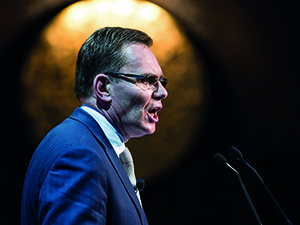
BHP Billiton CEO, Andrew Mackenzie, said there was limited capacity for the world’s mining sector to make further significant in-roads into safe productivity improvements which would make it an even greater competitive advantage in the future.
Speaking at the Bank of American Merrill Lynch 2016 Metals, Mining & Steel conference, Mackenzie said he had been surprised by the extent to which the mining sector had cut costs through productivity over the past three years.
However, the sector was “approaching the limits of what is possible given geological, geographical and skill constaints,” he said. “For many, if not all, the next step will be harder to take and will become an even greater differentiator into the future,” said Mackenzie.
BHP Billiton had achieved $10bn in annualised productivity gains over five years. It had also introduced better efficiencies in its capital allocation processes, reducing capital expenditure 70% over the period. “I remember sitting in my hotel room three years agonising over if I could commit to $15bn in capital expenditure a year,” said Mackenzie.
“But next year, we will spend no more than $5bn. It is amazing what is possible when you put your mind to things,” he added. The group had targeted free cash generation of $5bn by April next year.
Mackenzie’s comments come against a backdrop of improvements in certain metal prices so far in 2016, especially the gold and platinum mining sectors. Shares in BHP Billiton were flat so far this year, but there had been recoveries in the value of Glencore and Anglo American which were 44% and 71% stronger over the last 90 days.
Mackenzie believed, however, that the metals market would continue to be dominated by a new era of prolonged lower metal prices and volatility.
“We were surprised by the speed, quantum and correlation of price declines, but our actions over the last few years have positioned us for new era of economic uncertainty, market volatility and geopolitical stability, where markets will be oversupplied, sentiment cautious and [consist of] a period of lower commodity prices and volatility,” said Mackenzie.
Asked to expand on his view of the mining market going forward, Mackenzie said that his focus fell on emerging markets and that China was managing its transition into a services economy “with a few bumps” which “works for us in what we want to do with copper and petroleum.
He was “optimistic” about India growth in the long term which was good for metallurgical coal demand, but he added that if his optimism was “overdone” the company would take “different actions”.
“We won’t rush to invest … We would rather put capital into the hands of shareholders if this [his outlook regarding China and India] does not materialise,” he said.
Capital expenditure
In his presentation to the conference, Ivan Glasenberg, CEO of Glencore, said capital expenditure among the diversified mining companies would fall to an estimated $24bn this year from a high of $71bn in 2012.
He added that returns on some $1 trillion in projects racked up by the sector between 2003 and 2015 turned on decisions that management made from now onwards; in other words, efficiently and profitably matching supply to demand.
Commenting on cost controls, Glasenberg said whilst costs had been driven down steeply from about 2011/12, less than $350bn had been generated in free cash flow as price declines more than rubbed out lower costs.
Operating cash flow less capital expenditure fell from about $65bn in 2010 to an industry outflow of about $16bn in 2012 before recovering to just over $20bn last year.
However, Glasenberg said the future could be different for the mining sector, setting down a number of ingredients in the ‘recipe for growth’.
These included accepting that volume growth “cannot be an end in itself” and that growth should be “redefined to mean cash flow and earnings”. Investment decisions should also be premised on cash flow expectations rather than net present values, said Glasenberg.









